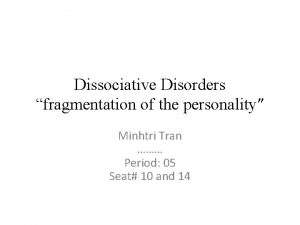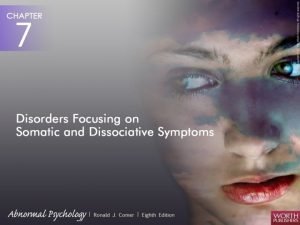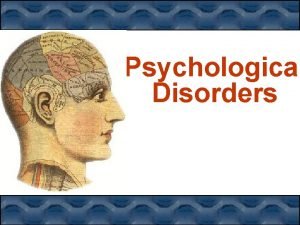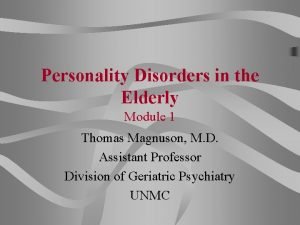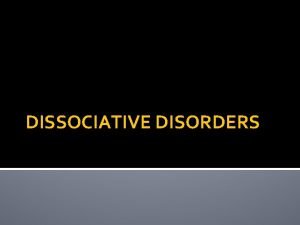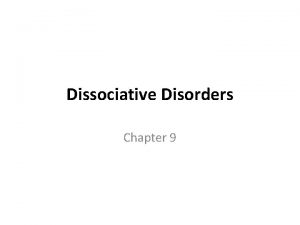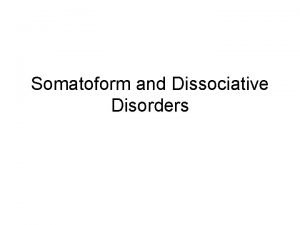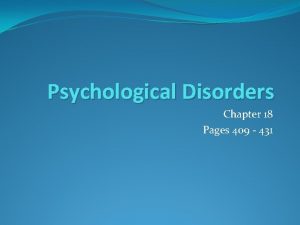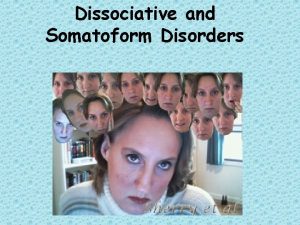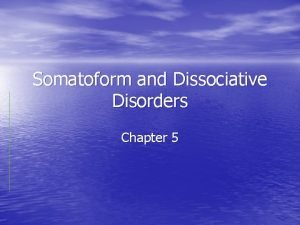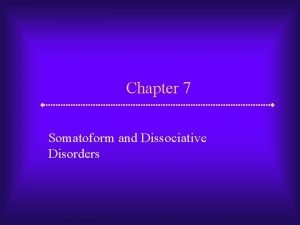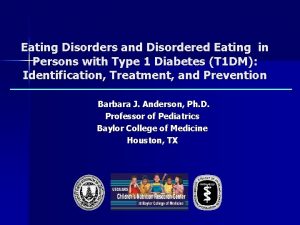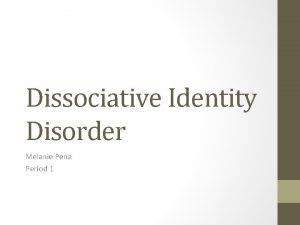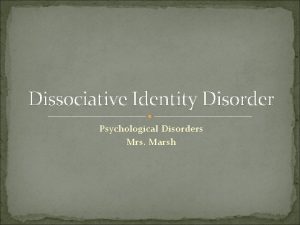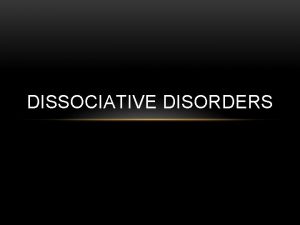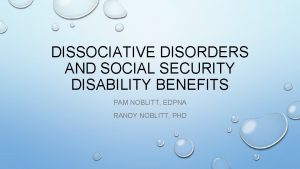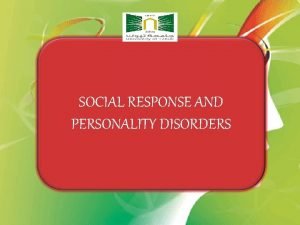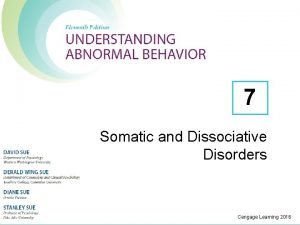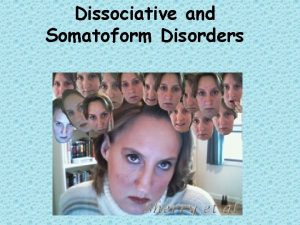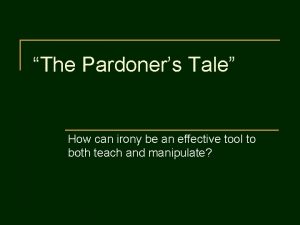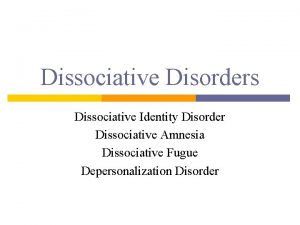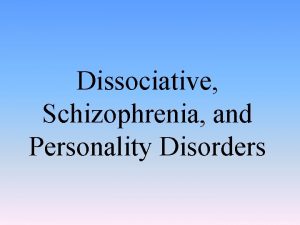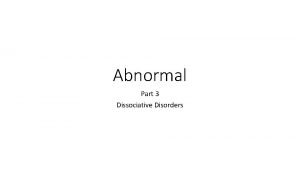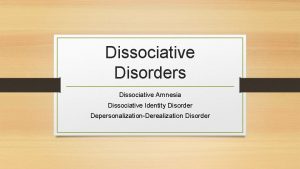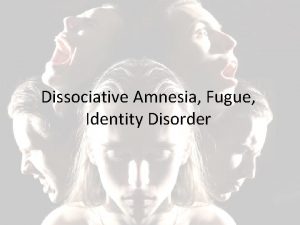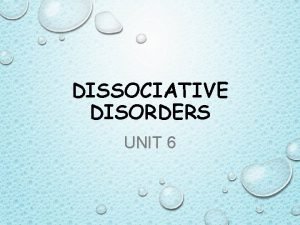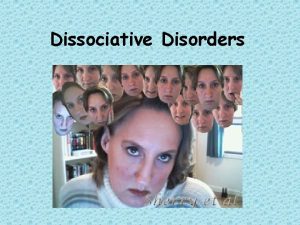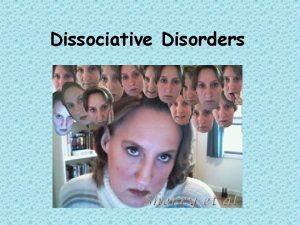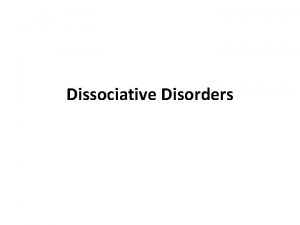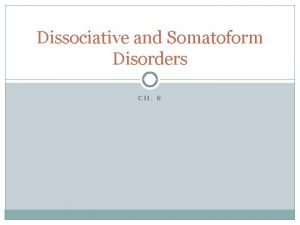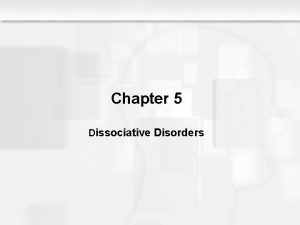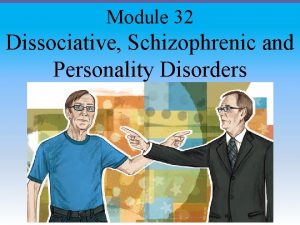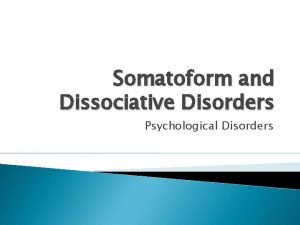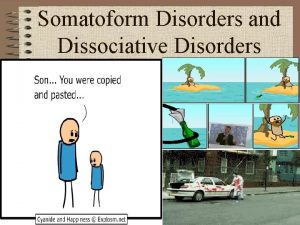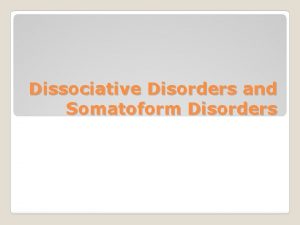Disorders Focusing on Dissociative Symptoms Disorders focusing on






























- Slides: 30


Disorders Focusing on Dissociative Symptoms Disorders focusing on dissociative symptoms include Dissociative amnesia Dissociative Identity disorder Depersonalization-derealization disorder

Dissociative Disorders The key to our identity – the sense of who we are and where we fit in our environment – is memory Our recall of past experiences helps us to react to present events and guides us in making decisions about the future People sometimes experience a major disruption of their memory: They may not remember new information They may not remember old information

Dissociative Disorders When such changes in memory lack a clear physical cause, they are called “dissociative” disorders In such disorders, one part of the person's memory typically seems to be dissociated, or separated, from the rest

Dissociative Disorders Types of dissociative disorders include: Dissociative amnesia Dissociative fugue Dissociative identity disorder (multiple personality disorder) Depersonalization -derealization disorder

Dissociative Amnesia People with dissociative amnesia are unable to recall important information, usually of an upsetting nature, about their lives The loss of memory is much more extensive than normal forgetting and is not caused by physical factors Often an episode of amnesia is directly triggered by a specific upsetting event

Dissociative Amnesia Dissociative amnesia may be: Localized – most common type; loss of all memory of events occurring within a limited period Selective – loss of memory for some, but not all, events occurring within a period Generalized – loss of memory beginning with an event, but extending back in time; may lose sense of identity; may fail to recognize family and friends Continuous – forgetting continues into the future; quite rare in cases of dissociative amnesia

Dissociative Fugue People with dissociative fugue not only forget their personal identities and details of their past, but also flee to an entirely different location For some, the fugue is brief – a matter of hours or days – and ends suddenly For others, the fugue is more severe: people may travel far from home, take a new name and establish new relationships, and even a new line of work; some display new personality characteristics Fugues tend to end abruptly

Dissociative Identity Disorder (Multiple Personality Disorder) A person with dissociative identity disorder (DID; formerly multiple personality disorder) develops two or more distinct personalities (subpersonalities) each with a unique set of memories, behaviors, thoughts, and emotions

Dissociative Identity Disorder (Multiple Personality Disorder) At any given time, one of the subpersonalities dominates the person's functioning Usually one of these subpersonalities – called the primary, or host, personality – appears more often than the others The transition from one subpersonality to the next (“switching”) is usually sudden and may be dramatic Most cases are first diagnosed in late adolescence or early adulthood Symptoms generally begin in childhood after episodes of abuse Typical onset is before age 5 Women receive the diagnosis three times as often as men

How Do Subpersonalities Interact? Generally there are three kinds of relationships: Mutually amnesic relationships – subpersonalities have no awareness of one another Mutually cognizant patterns – each subpersonality is well aware of the rest One-way amnesic relationships – most common pattern; some personalities are aware of others, but the awareness is not mutual Those who are aware (“co-conscious subpersonalities”) are “quiet observers”

How Do Subpersonalities Interact? Investigators used to believe that most cases of the disorder involved two or three subpersonalities Studies now suggest that the average number is much higher – 15 for women, 8 for men There have been cases of more than 100

How Do Subpersonalities Differ? Subpersonalities often display dramatically different characteristics, including: Identifying features Abilities and preferences Subpersonalities may differ in features as basic as age, sex, race, and family history Although encyclopedic information is not usually affected by dissociative amnesia or fugue, in DID it is often disturbed It is not uncommon for different subpersonalities to have different abilities, including being able to drive, speak a foreign language, or play an instrument Physiological responses Researchers have discovered that subpersonalities may have physiological differences, such as differences in autonomic nervous system activity, blood pressure levels, and allergies

Dissociative Identity Disorder (Multiple Personality Disorder) How common is DID? Traditionally, DID was believed to be rare The number of people diagnosed with the disorder has been increasing Although the disorder is still uncommon, thousands of cases have been documented in the U. S. and Canada alone Two factors may account for this increase: A growing number of clinicians believe that the disorder does exist and are willing to diagnose it Diagnostic procedures have become more accurate Despite changes, many clinicians continue to question the legitimacy of this category

How Do Theorists Explain Dissociative Amnesia and Dissociative Identity Disorder? A variety of theories have been proposed to explain dissociative disorders Older explanations have not received much investigation Newer viewpoints, which combine cognitive, behavioral, and biological principles, have captured the interest of clinical scientists

How Do Theorists Explain Dissociative Amnesia and Dissociative Identity Disorder? The psychodynamic view • Psychodynamic theorists believe that dissociative disorders are caused by repression, the most basic ego defense mechanism • People fight off anxiety by unconsciously preventing painful memories, thoughts, or impulses from reaching awareness • In this view, dissociative amnesia and fugue are single episodes of massive repression • DID is thought to result from a lifetime of excessive repression, motivated by very traumatic childhood events

How Do Theorists Explain Dissociative Amnesia and Dissociative Identity Disorder? The psychodynamic view • Most of the support for this model is drawn from case histories, which report brutal childhood experiences, yet: • Some individuals with DID do not seem to have these experiences of abuse • Further, why might only a small fraction of abused children develop this disorder?

How Do Theorists Explain Dissociative Amnesia and Dissociative Identity Disorder? The behavioral view • Behaviorists believe that dissociation grows from normal memory processes and is a response learned through operant conditioning: • Momentary forgetting of trauma leads to a drop in anxiety, which increases the likelihood of future forgetting • Like psychodynamic theorists, behaviorists see dissociation as escape behavior • Also like psychodynamic theorists, behaviorists rely largely on case histories to support their view of dissociative disorders • Moreover, these explanations fail to explain all aspects of these disorders

How Do Theorists Explain Dissociative Amnesia and Dissociative Identity Disorder? State-dependent learning • If people learn something when they are in a particular state of mind, they are likely to remember it best when they are in the same condition • This link between state and recall is called state-dependent learning • This model has been demonstrated with substances and mood and may be linked to arousal levels

How Do Theorists Explain Dissociative Amnesia and Dissociative Identity Disorder? State-dependent learning • People who are prone to develop dissociative disorders may have state-tomemory links that are unusually rigid and narrow; each thought, memory, and skill is tied exclusively to a particular state of arousal, so that they recall a given event only when they experience an arousal state almost identical to the state in which the memory was first acquired

How Do Theorists Explain Dissociative Amnesia and Dissociative Identity Disorder? Self-hypnosis • Although hypnosis can help people remember events that occurred and were forgotten years ago, it can also help people forget facts, events, and their personal identity • Called “hypnotic amnesia, ” this phenomenon has been demonstrated in research studies with word lists • The parallels between hypnotic amnesia and dissociative disorders are striking and have led researchers to conclude that dissociative disorders may be a form of self-hypnosis

How Are Dissociative Amnesia and Dissociative Identity Disorder Treated? People with dissociative amnesia and fugue often recover on their own Only sometimes do their memory problems linger and require treatment In contrast, people with DID usually require treatment to regain their lost memories and develop an integrated personality Treatment for dissociative amnesia and fugue tends to be more successful than treatment for DID

How Do Therapists Help People With Dissociative Amnesia And Fugue? The leading treatments for these disorders are psychodynamic therapy, hypnotic therapy, and drug therapy Psychodynamic therapists guide patients to search their unconscious and bring forgotten experiences into consciousness In hypnotic therapy, patients are hypnotized and guided to recall forgotten events Sometimes intravenous injections of barbiturates are used to help patients regain lost memories Often called “truth serums, ” the key to the drugs' success is their ability to calm people and free their inhibitions

How Do Therapists Help Individuals With DID? Unlike victims of dissociative amnesia or fugue, people with DID do not typically recover without treatment Treatment for this pattern, like the disorder itself, is complex and difficult

How Do Therapists Help Individuals With DID? Recognizing the disorder • Once a diagnosis of DID has been made, therapists try to bond with the primary personality and with each of the subpersonalities • As bonds are forged, therapists try to educate the patients and help them recognize the nature of the disorder • Some use hypnosis or video as a means of presenting other subpersonalities • Many therapists recommend group or family therapy

How Do Therapists Help Individuals With DID? Recovering memories • To help patients recover missing memories, therapists use many of the approaches applied in other dissociative disorders, including psychodynamic therapy, hypnotherapy, and drug treatment • These techniques tend to work slowly in cases of DID

How Do Therapists Help Individuals With DID? Integrating the subpersonalities • The final goal of therapy is to merge the different subpersonalities into a single, integrated identity • Integration is a continuous process; fusion is the final merging • Many patients distrust this final treatment goal and their subpersonalities see integration as a form of death • Once the subpersonalities are integrated, furtherapy is typically needed to maintain the complete personality and to teach social and coping skills to prevent later dissociations

Depersonalization-Derealization Disorder DSM-5 categorizes depersonalizationderealization disorder as a dissociative disorder, even though it is not characterized by the memory difficulties found in the other dissociative disorders Its central symptom is persistent and recurrent episodes of depersonalization (the sense that one’s own mental functioning or body are unreal or detached) and/or derealization (the sense that one’s surroundings are unreal or detached)

Depersonalization Disorder People with this disorder feel as though they have become separated from their body and are observing themselves from outside This sense of unreality can extend to other sensory experiences and behavior Depersonalization experiences by themselves do not indicate a depersonalization disorder Transient depersonalization reactions are fairly common The symptoms of a depersonalization disorder are persistent or recurrent, cause considerable distress, and interfere with social relationships and job performance

Depersonalization Disorder The disorder occurs most frequently in adolescents and young adults, hardly ever in people older than 40 The disorder comes on suddenly and tends to be longlasting Few theories have been offered to explain the disorder and little research has been conducted on the problem
 Dissociative identity disorder
Dissociative identity disorder What is dissociative amnesia
What is dissociative amnesia Dissociative disorders
Dissociative disorders Chapter 29 somatic symptom and dissociative disorders
Chapter 29 somatic symptom and dissociative disorders Types of dissociative disorders
Types of dissociative disorders Period symptoms vs pregnancy symptoms
Period symptoms vs pregnancy symptoms Cluster c personality disorders symptoms
Cluster c personality disorders symptoms Dissociative disorder not otherwise specified
Dissociative disorder not otherwise specified Nursing diagnosis of dissociative disorder
Nursing diagnosis of dissociative disorder Depersonalization disorder
Depersonalization disorder Associative and dissociative social process
Associative and dissociative social process Austin woodbury
Austin woodbury Dissociative disorder
Dissociative disorder Disociative fugue
Disociative fugue Dissociative disorder
Dissociative disorder Dissociative amnesia
Dissociative amnesia Dissociative disorder not otherwise specified
Dissociative disorder not otherwise specified Melanie pena
Melanie pena La belle indifference definition
La belle indifference definition Bask model of dissociation
Bask model of dissociation Fugue dissociative
Fugue dissociative Dissociative disorder
Dissociative disorder Dissociative fugue
Dissociative fugue Dissociative identity disorder social security disability
Dissociative identity disorder social security disability Dissociative disorder not otherwise specified
Dissociative disorder not otherwise specified Cengage
Cengage Dissociative fugue state
Dissociative fugue state Lwws
Lwws Microscope
Microscope Three examples of irony in the pardoner's tale
Three examples of irony in the pardoner's tale Fungsi dari metalic focusing cup adalah
Fungsi dari metalic focusing cup adalah

